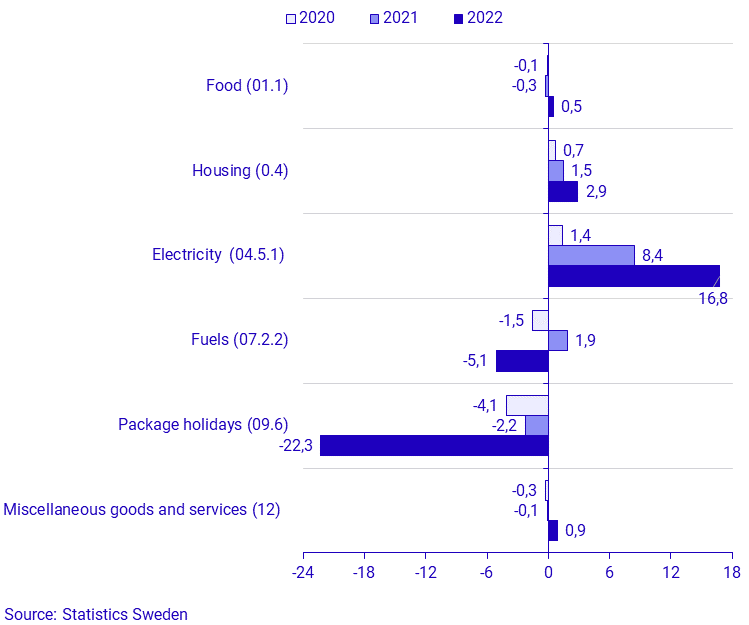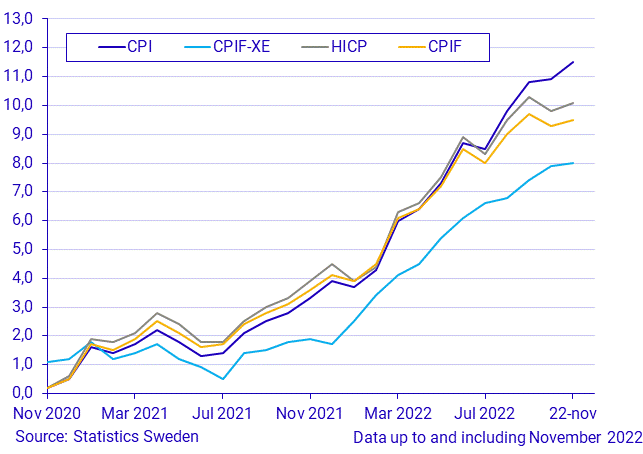Consumer Price Index (CPI), November 2022
Inflation rate according to CPIF was 9.5 percent in November 2022
Statistical news from Statistics Sweden 2022-12-14 8.00
The CPIF (Consumer Price Index with fixed interest rate) 12-month inflation rate was 9.5 percent in November 2022, up from 9.3 percent in October. On a monthly basis, the inflation rate according to the CPIF increased by 0.7 percent from October to November.
“Electricity prices increased in November which contributed to a higher inflation rate”, says Carl Mårtensson, statistician at Statistics Sweden
In brief
| Index Numbers |
Monthly changes, percent |
Annual changes, percent |
|
|---|---|---|---|
| CPI (1980=100) | 387.93 | 1.0 | 11.5 |
| CPIF (1987=100) | 250.10 | 0.7 | 9.5 |
| CPIF-XE (1987=100) | 229.98 | 0.2 | 8.0 |
- Increased interest expenses contributed with about 2.1 percentage points to the inflation rate according to CPI which amounted to 11.5 percent
- Electricity prices increased by 16.8 percent between October and November
- Food prices have increased for the twelfth month in a row
- The inflation rate according to CPIF excluding energy increased from 7.9 percent in October to 8.0 percent in November
Increasing electricity prices
The CPIF increased by 0.7 percent from October to November. In the corresponding period a year ago, the CPIF rose by 0.5 percent.
The monthly rate of change was mainly affected by increasing electricity prices in November which contributed to increasing costs of home ownership. Food prices increased for the twelfth month in a row. Miscellaneous goods and services also increased in price. The upward contributions to the monthly change were offset by falling prices for fuel and package holidays.
The table below shows changes on a monthly basis and contributions to the CPIF based on the goods and services that had the greatest impact on the CPIF in November 2022. The results are presented by COICOP category. COICOP refers to the United Nations classification of household consumption expenditure.
| Category (Coicop) | Monthly changes, percent |
Contribution to CPIF Monthly change, percentage points |
|---|---|---|
| Food (01.1) | 0.5 | 0.1 |
| Housing (04) | 2.9 | 0.7 |
| Electricity (04.5.1) | 16.8 | 0.7 |
| Fuels (07.2.2) | ‑5.1 | ‑0.2 |
| Package holidays (09.6) | ‑22.3 | ‑0.1 |
| Miscellaneous goods and services (12) | 0.9 | 0.1 |

Seasonal patterns and temporary price changes
Price changes on goods and services may be seasonal or temporary. The figure above shows the monthly changes this year and in the two preceding years for those goods and services which had the largest impact on the CPIF monthly change.
Electricity prices increased for the third year in a row but stands out in its increase in 2022. Electricity is a big part of costs of home ownership, which explains that costs of home ownership follows the same trend. The price of package holidays usually decreases in November, but decreased more than usual in 2022.
The price increased in 2022 for food and miscellaneous goods and services, which they did not do in the corresponding period the two previous years. Fuel prices decreased in November 2022 while it increased in 2021 and decreased in 2020.
Increasing inflation rate in November
The inflation rate according to CPIF, that is, the change in CPIF from the same month of the previous year, was 9.5 percent in November 2022. This is a increase from October when the inflation rate was 9.3 percent.
The inflation rate according to the CPI, which unlike CPIF is affected by changes in interest rates, was 11.5 percent in November. This is an increase compared to October when it was 10.9 percent.
Prices on food and non-alcoholic beverages had an impact on the inflation rate. The main contributions within this group came from price increases on milk, eggs and cheese. Transport also noted a positive annual rate where a large part of the contribution came from increased fuel prices, as well as rising prices for cars.
Rising prices for electricity, gas and other fuels had a major impact on the housing costs together with increasing costs of maintenance and repair of the dwelling. Also, rising prices for recreation and culture, furnishings and household equipment, restaurant visits and personal care contributed to the rate of inflation.
The inflation rate calculated excluding energy products (CPIF-XE) was 8.0 percent in November, which is an increase compared to October when it was 7.9 percent.
| Category (Coicop) | Yearly change, percent |
Contribution yearly change CPIF percentage points |
|---|---|---|
| Food and alchoholfree bevearges (01) | 18.1 | 2.5 |
| Housing (04) | 9.8 | 2.4 |
| Electricity (04.5.1) | 36.8 | 1.3 |
| Maintenance and repair of the dwelling (part of 04.x) | 10.2 | 0.3 |
| Furnishings and household goods (05) | 15.4 | 1.1 |
| Furniture (05.1) | 20.5 | 0.5 |
| Transport (07) | 10.3 | 1.5 |
| Cars (07.1.1) | 8.9 | 0.5 |
| Fuels (07.2.2) | 23.6 | 0.7 |
| Recreation and culture (09) | 4.2 | 0.5 |
| Restaurants (11.1) | 8.9 | 0.5 |
| Personal care (12.1) | 10.5 | 0.3 |
CPI and CPIF, two different measures of inflation
From the publication that takes place in February 2023, the statistical news will shift the main focus from CPIF to CPI. It will affect the title and the introduction, but also in the tables and diagrams that are presented. CPIF will continue to be presented in the statistical news. The reason behind the change in the statistical news is an increased interest in the general price trend in Sweden as shown by the CPI.
CPI and CPIF are two different measures of inflation that Statistics Sweden calculates. The Consumer Price Index (CPI) is best known, but it is the CPIF that is the measure that the Riksbank uses in its inflation target. The CPIF includes the same goods and services as the CPI. The difference between CPI and CPIF is that in CPIF, interest rates for households are kept constant. This means that CPIF is not affected by changes in interest rates for households, while it has an effect in CPI.
Compilation method for 2023 weights
The weights used to compile the CPI, HICP and other measures of consumer side inflation are updated on an annual basis. Statistics Sweden has decided that the 2023 update will be based on the same method as was used for 2021 and 2022. For more information, see:
Different measures of inflation
Statistics Sweden calculates different inflation measures for different purposes. The CPIF is the Riksbank’s target variable, while the CPI is the measure used for purposes of compensation.

Definitions and explanations
The CPIF shows the same price trend as the CPI, but without the direct effects of a changed monetary policy. The CPIF is the Riksbank’s target variable for the inflation target.
The CPIF excluding energy (CPIF-XE) and the CPIF with constant tax (CPIF-CT) are two other measures of inflation produced by Statistics Sweden on behalf of the Riksbank. In the CPIF-XE, energy products are excluded from the CPIF, while in the CPIF-CT the taxes and subsidies associated with the products in the CPIF are kept constant.
The HICP (Harmonised Index of Consumer Prices) is produced by all EU Member States. This measure has a somewhat smaller coverage than the CPI and the CPIF, mainly because parts of households’ housing costs are omitted.
Next publishing will be
2023-01-13 at 8:00.
Statistical Database
More information is available in the Statistical Database
Feel free to use the facts from this statistical news but remember to state Source: Statistics Sweden.
